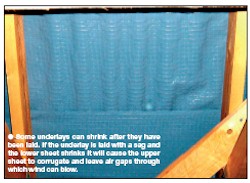 |
 |
 |
 |
 |
 |
 |
|
Check out our web directory of the UK
roofing and cladding industry
www.roofinfo.co.uk |
Sign up for our monthly news letter. |
|
|
|

Underlay is something we all take for granted. It must be used under the
battens, and rolled out in horizontal bands lapped progressively up the
roof slope and over any ridge or hip – whether bitumen or plastic based.
However, there are some rules that need to be observed to ensure the
underlay is installed correctly.
Lap
Underlay will inevitably lap over
another, ensuring that any water on the underlay stays outside and does
not find a way in.
Horizontal laps, or headlaps, are the easiest laps to
install correctly – by measuring down from the top edge of the underlay
the amount of lap required, and marking with a wet chalk line or a
temporary batten. The next layer of underlay is rolled out with the
lower edge against the marked line or batten and is temporarily nailed
into position. A 100mm lap is permissible provided the underlay is not
laid directly onto rigid insulation or boarding, and the rafter pitch is
35° or steeper.
Below 35° the lap needs to be increased. From 15° to
34° the lap should be increased to 150mm, and between 12.5° and 14° the
lap should be 225mm. If the underlay is laid directly onto rigid
insulation or boarding then the laps can be reduced to 75mm for 35° and
above, 100mm for 15°-34°, and 150mm for 12.5°-14°.
Vertical laps or, side-laps, should always be 100mm
regardless of the rafter pitch of the roof. On a fully supported roof
the lap is easily supported, with no rigid insulation or boarding, but a
100mm side lap is sometimes compromised if the end of a roll occurs
between rafters. The 100mm lap should be taken from the end of the new
piece of underlay to the furthest edge of the last rafter (not the end
of the lower piece of underlay).
If you are laying underlay on a curved roof it will be
impossible to lay it in horizontal bands due to the changing radius of
the roof. Therefore, the underlay ends up being laid in sweeping curves
so that the laps are neither horizontal nor vertical. In this instance
the larger head-lap figure pitch should be used.
Where quilt insulation has been installed to the full
depth of the rafters, and the underlay is in direct contact with the
insulation, this is not classified as fully supported. Over time the
insulation is likely to shrink down and leave the underlay unsupported.
Sag
Where the underlay is laid over
the rafters (with no support between the rafters) there should be a sag
in the underlay. This forms a trough down which any water can run,
passing under the tile battens and exiting at the eaves. However, the
amount of sag will vary. The recommended 25mm of sag measured at mid
span is the maximum ideal to ensure that if sucked up by the wind, it
does not reach the underside of the roof tiles or slates and push them
off the battens. No sag in the underlay will hold the underlay tight
against the underside of the battens and will trap water and debris
between the underlay and the battens, restricting air movement in the
batten cavity.
A small sag is better than no sag, but unfortunately
some underlay material will shrink after it has been installed and go
drum tight. In some instances it will pull apart in a similar way to the
old building paper underlay of the 1920s and 30s. Additional sag should
be created to compensate for the natural shrinkage in some material,
ensuring that there is some sag once it has finished shrinking. However,
the amount of shrinkage can vary from one end of a roll to another and
one material to another. Even the manufacturers/suppliers can only guess
at a figure, with the exception of Type 1F Hessian reinforced bituminous
underlay, which is very stable. |
 |
The shrinkage of the underlay can present
problems with the laps in the underlay. If the upper sheet shrinks more
than the lower sheet, the laps will open up and allow wind to blow into
the roof – in some instances this can generate a vibration or whistle
through the open lap. If the lower sheet shrinks more than the upper
sheet then the upper sheet will start to corrugate as it has nowhere to
go (see photo).
Once an underlay, in the course of shrinking, has taken
up all the sag, and the underlay is flat, further shrinkage will cause
the nail holes through the underlay to elongate. There will always be
nail holes through the underlay. Water trapped between the underlay and
the batten will track along the batten and may find its way down through
a hole. This will show itself as a damp spot on the rafter, especially
with a lowpitch roof.Wind
Before the battens are installed the underlay is vulnerable because the
battens are its secure fixing. Felt tacks, or batten nails turned over,
are only temporary fixings until the battens are installed. Severe winds
can rip the underlay off. In Scotland counter battens hold down the
underlay onto the rigid sarking, so the wind does not remove it and to
provide a gap between the underlay and the tile or slate battens.
Wind can lift the free edge of any sheet of
underlay very easily. It is advisable to always hold down all laps with
an extra batten, as battening progresses. Once the slates or tiles are
installed the wind can still suck up the free edge of the underlay,
making contact with the underside of the tiles or slates if
unrestrained. Underlay material that is stretchy can also elongate under
severe wind suction loads, causing the underlay to make contact with the
underside of the tiles or slates. The recommendations for these
materials are to lay the material tight with a 25mm counter batten
above, plus 25mm tile or slate battens, making a 50mm distance between
the underlay and the underside of the tiles or slates.
Conclusion
While some underlay materials are light, clean, vapour permeable, and
strong enough to stop a man falling through them, they still need to
have the same lap, sag, and resistance to shrinkage as traditional
bituminous underlay.
Tips
- Always measure the rafter pitch with a
pitch gauge before you start work, as it may vary from the drawings/
specification.
- The head-lap in the underlay will
increase as the rafter pitch gets lower.
- There must always be a gap between the
top of the underlay and the underside of the tile or slate battens at
mid span.
- Hold down the free edge of the
underlay, within 50mm of the edge, with an additional batten to
prevent the wind lifting it and making contact with the underside of
the tiles or slates.
|
| Compiled
by Chris Thomas, The Tiled Roofing Consultancy, 2 Ridlands Grove,
Limpsfield Chart, Oxted, Surrey, RH8 0ST, tel 01883 724774 |
|